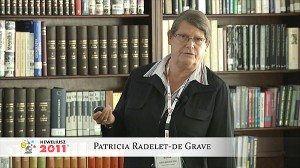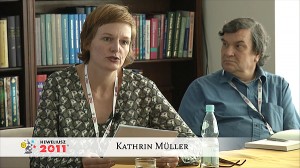Konferencja Hevelius 2011 – Sesja 4 – Jennifer Downes
 Temat: Księżyc w druku: ryciny i mapy w dziele Selenographia (1647) Jana Heweliusza.
Temat: Księżyc w druku: ryciny i mapy w dziele Selenographia (1647) Jana Heweliusza.
Wyniki teleskopowych obserwacji Księżyca, opublikowane w 1647 roku przez Jana Heweliusza w jego dziele Selenographia, ukazały „ziemską” naturę Księżyca, z jego górami, dolinami i innymi tworami powierzchni, opisanymi przez Galileusza w książce Sidereus nuncius (1610). Heweliusz podjął się nie tylko przygotowania szczegółowych obrazów Księżyca, lecz także stworzenia księżycowej geografii: oprócz realistycznych przedstawień Księżyca powstały całościowe jego mapy oraz księżycowa nomenklatura. Za pomocą swoich precyzyjnych teleskopowych pomiarów Heweliusz wyznaczył położenia cech księżycowej powierzchni, a następnie stworzył zestaw drukowanych rycin, mając nadzieję, że staną się one standardem dla astronomów w ich przyszłych badaniach. Według Mary Winkler i Alberta Van Heldena Selenografii Heweliusza zawdzięczamy ukształtowanie się precyzyjnego, realistycznego wizualnego języka astronomii – przy tym ów wkład gdańszczanina szybko uznano za tak oczywisty, że przestał właściwie być zauważany przez historyków nauki.
Jednakże miejsce Selenografii wśród istniejących w okresie wczesnonowożytnym gatunków przedstawień kosmograficznych – z jednej strony, chorograficznych obrazów, ukazujących wygląd wybranych miejsc; z drugiej strony, map „geograficznych”, obejmujących cały świat, z systemem współrzędnych szerokości i długości geograficznej do określania położenia -nie było jednoznaczne. Inaczej bowiem traktowano teleskop jako instrument pomiarowy w tradycyjnej praktyce matematycznej – zgodnie z którą obrazy niekoniecznie muszą odzwierciedlać rzeczywisty wygląd rzeczy – inaczej zaś w roli instrumentu służącego do przygotowania naturalistycznego przedstawienia obiektu. W wystąpieniu tym przedyskutowane zostanie, w jaki sposób Heweliuszowe „ziemiopodobne” obrazy Księżyca miały się do typów przedstawień stosowanych we wczesnonowożytnej kartografii oraz z jakim odbiorem się spotkały i jaki wywarły wpływ.
materiał w języku angielskim
Jennifer Downes (University of Aberdeen, Scotland, UK):
Printing the Moon: Images and Maps in Johannes Hevelius’s Selenographia (1647)
Johannes Hevelius’s series of telescopic observations of the Moon published in Selenographia in 1647 revealed in more detail the ‘earth-like’ Moon, with mountains, valleys and other features similar to terrestrial ones, which Galileo Galilei had described in Sidereus nuncius (1610). As well as creating detailed visual images of the Moon, Hevelius undertook a full-scale project of lunar geography: not just establishing a realistic image of the Moon, but comprehensively mapping and naming its features. Hevelius’s telescopes were instruments of precision measurement, used to plot the relative positions of lunar features and to create what Hevelius hoped would be a standardised set of printed images that astronomers could use to record future observations. Mary Winkler and Albert Van Helden have argued that Hevelius’s observations in Selenographia established criteria for accurate, realistic visual representation in astronomy; an achievement that was quickly taken for granted, and has thus remained largely invisible to historians of science.
However, Selenographia fitted ambiguously into the existing genres of cosmographical images in the early modern period: on the one hand, chorographical images, drawings of the appearance of specific places; and on the other hand, ‘geographical’ maps on the world-scale, where co-ordinates of latitude and longitude identified individual locations. There was a tension between the use of the telescope as an instrument of naturalistic description, and as an instrument of measurement in the tradition of practical mathematics – a tradition in which visual images did not necessarily represent the real appearance of things. This paper will discuss how Hevelius’s images of an earth-like Moon related to the types of images used in early modem terrestrial map-making, what the implications of these existing genres were for Hevelius’s astronomical projects, and how the images were received and re-used by contemporary audiences.


